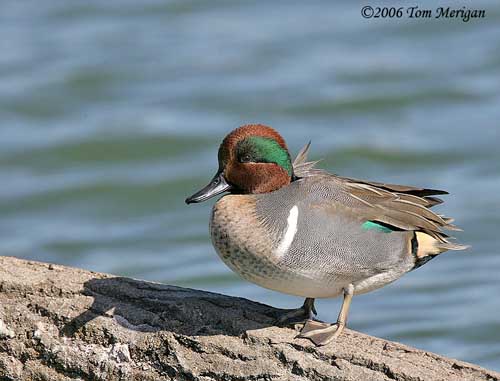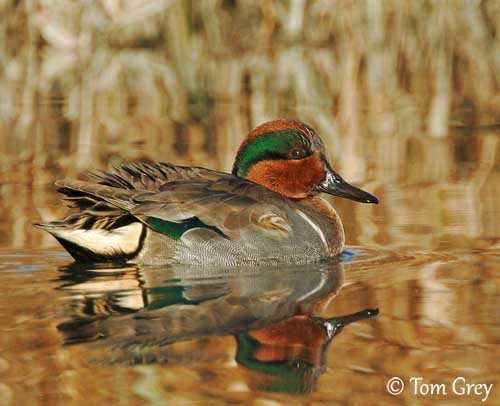
Fr : Sarcelle à ailes vertes
All : Amerikanische Krickente
Esp: Cerceta americana
Ital : Alzavola americana
Nd: Amerikaanse Wintertaling
Sd: Amerikansk kricka
Photographers:
Tom Grey
Tom Grey's Bird Pictures
Tom Merigan
Tom Merigan’s Photo Galleries
Text by Nicole Bouglouan
Sources:
HANDBOOK OF THE BIRDS OF THE WORLD vol 1 by Josep del Hoyo-Andrew Elliot-Jordi Sargatal - Lynx Edicions - ISBN: 8487334105
GUIDE DES CANARDS, DES OIES ET DES CYGNES – de Steve Madge - Delachaux et Niestlé - ISBN: 2603013769
A GUIDE TO THE BIRDS OF MEXICO AND NORTHERN CENTRAL AMERICA by Steve N. G. Howell, Sophie Webb - Oxford University Press - ISBN: 0198540124
BirdLife International (BirdLife International)
Animal Diversity Web (University of Michigan Museum of Zoology)
Bird Web (Seattle Audubon Society)
Wikipedia, the free encyclopaedia
Green-winged Teal
Anas carolinensis
Anseriforme Order – Anatidae Family
BIOMETRICS:
Length: 34-38 cm
Wingspan: 58 cm
Weight: Male: 359 g - Female: 320 g
DESCRIPTION:
The Green-winged Teal is a North American species. This Anatidae was formerly a subspecies of the Eurasian Teal (Anas crecca), but it is now a full species. This bird is named from the green speculums of the wings.
The adult male has cinnamon head, with glossy green lateral band around and behind the eye to the nape, and edged below by a narrow yellowish stripe.
The bill is dark grey to black. The eyes are dark brown. Legs and webbed feet are blackish.
The upperparts are grey, slightly washed brown with narrow vermiculations. The flight feathers are grey whereas the wing-coverts are more sooty-grey. In flight, the green, buff-edged speculum is conspicuous.

On the underparts, the breast is yellowish-white spotted brown, with a vertical white stripe on each side. Flanks and rest of underparts are pale grey and narrowly vermiculated too. The centre of the underparts is mostly whitish from the lower breast. The underwing is grey and the underwing-coverts are whitish. The undertail-coverts are pale yellow with black edges. The tail feathers are grey.
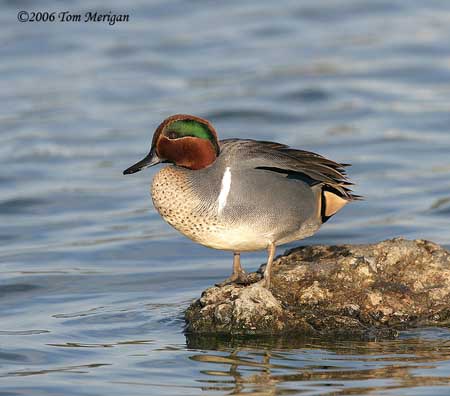
The adult female has light brown head and neck, and black eye stripe. The throat is whitish. The upperparts are dark brown, mottled paler brown, and the underparts are white. She has a green wing speculum too, usually more conspicuous than that of the male.
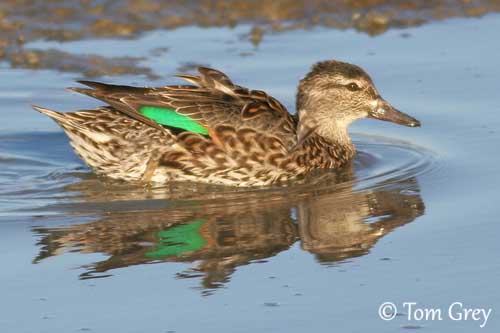
The immature has grey bill with orange edges. Its plumage is pale brown with darker spots. The crown is darker and the eye stripe is narrower, but it resembles adult as soon as the early winter.
VOICE: SOUNDS BY XENO-CANTO
The Green-winged Teal is relatively silent, but it may become very noisy too, according to the season.
The female utters some high-pitched “quack” when she is in water. The male gives a distinct high-pitched “priip-priip”.
HABITAT:
The Green-winged Teal frequents shallow marshes and lakes, coastal marshes with thick vegetation, mudflats and estuaries. It is also found in boreal forest and deciduous woodlands, grassy areas and parks.
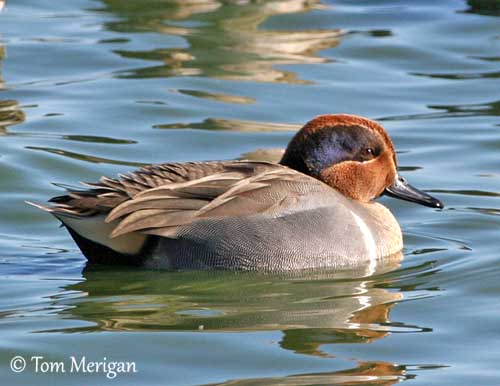
RANGE:
The Green-winged Teal breeds in Canada, Alaska, Maine, N Dakota, Minnesota and N Michigan.
It winters southwards, in W and S United States, in Mexico to Honduras and West Indies.
BEHAVIOUR:
The Green-winged Teal feeds by dabbling at water surface in shallow lakes or ponds and close to the shore. It searches for preys in the mud, often tadpoles. It is able to filter the mud with the bill.
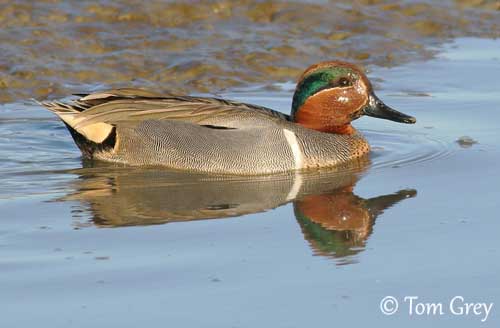
This species is very gregarious outside the breeding season.
During courtship displays, between September and November, we can see several males swimming around a female with conspicuous movements while uttering low whistles. If the female chooses a mate, it will chase away the rivals. Pairs form during winter and are monogamous. But the breeding males may copulate with other females during the breeding season.
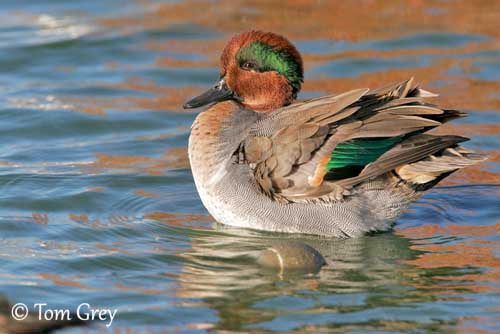
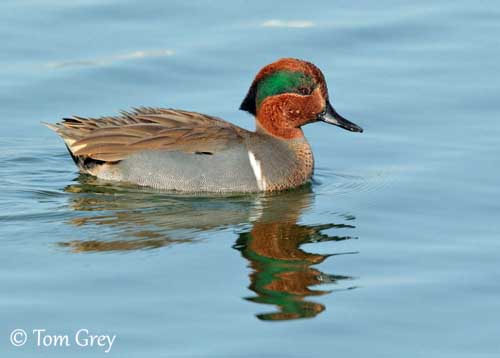
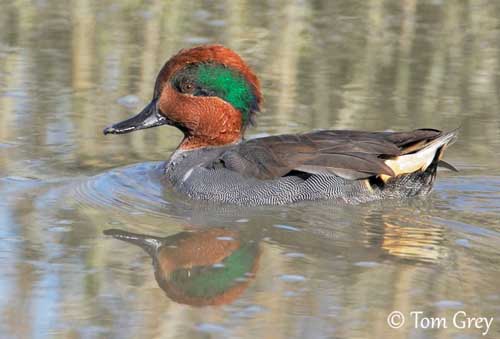
The Green-winged Teal is migratory. It travels in small groups but they may gather in large numbers at stopovers.
FLIGHT:
When the Green-winged Teal flies with broadly open wings, the green speculum is conspicuous. The fast, circling flight may recall that of shorebirds. Ensemble movements are spectacular when the birds move together, performing circles, spirals and changes of direction. This species is one of the most rapid and agile ducks in flight.
REPRODUCTION:
The Green-winged Teal may breed very well in captivity, and may use artificial nest-boxes too.
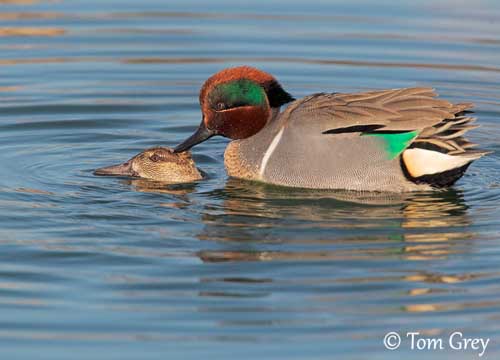
But in wild, the breeding season starts in early May. The female builds a nest concealed in tall grass or in dense vegetation, sometimes in dry area, but often on wet ground or near water, often a small shallow permanent pond. The nest is made with grass, and lined with down.
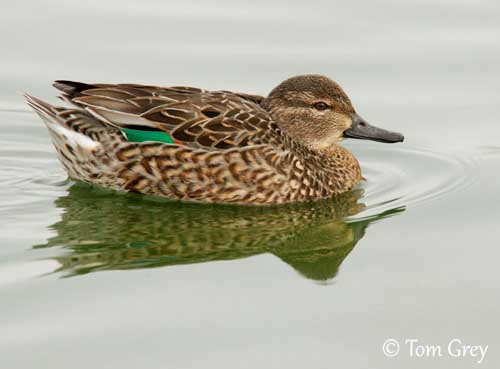
She lays 6-12 creamy eggs and incubates during about 23 days. The male does not take part in nesting duties. She cares, broods and protects the chicks, and keeps them warm against the cold weather. They are covered with down. They leave the nest very soon after hatching.
The female leads them to water and food sources, and chases away the predators by performing distraction displays. The young can fly at about six weeks old.
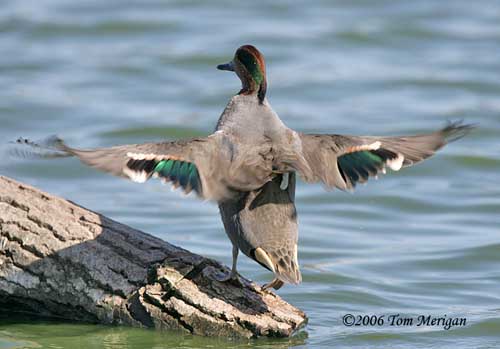
DIET:
The Green-winged Teal feeds on plant matter such as seeds, green parts of aquatic plants and other terrestrial species, acorns and berries. It also consumes marine invertebrates, aquatic insects, snails and worms.
PROTECTION / THREATS / STATUS:
The Green-winged Teal is vulnerable to hunting pressure, but its populations appear stable. This species is one of the most abundant in its wide range. It is not currently threatened.
